Swim Lessons for Kids
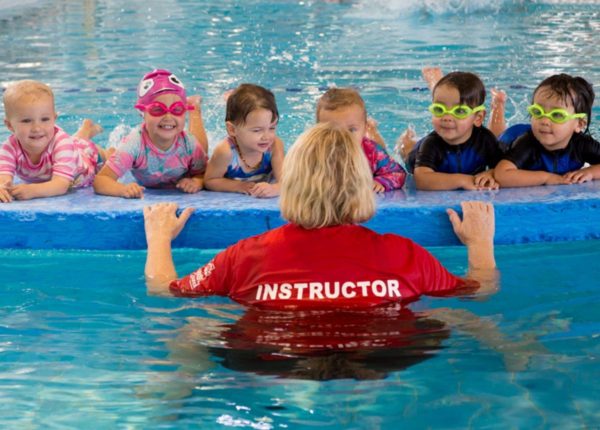
Here comes summer, and with it one of my favorite things ever: swim season.
I love swimming. I grew up in Massachusetts with ready access to a pool, learned to swim when I was too young to remember (from my mom!), and have SO many wonderful memories playing in the pool with my siblings. So naturally, I always imagined my kids would be swimming laps by their third birthdays.
Whelp, I missed the boat on that one. Now I live in Maine, where hardly anyone has a pool and the water is never, ever warm enough to swim in. But this year, I’m committed to getting my toddlers in the water, come hell or, well, high water.
This article highlights some of the central elements in water safety as well as your basic options for kids’ swim lessons.
But first, let’s get this out of the way…
Drowning and Water Safety
Sadly, drowning is a leading cause of death for children ages 1 to 4, and the highest rates are among toddlers (12 to 36 months is the highest risk period).
Given this kind of data, I was surprised to learn that the American Academy of Pediatrics (AAP) didn’t actually recommend swim lessons for children younger than 4 years old until 2019. In fact, prior to 2010, it actually discouraged parents from enrolling babies and toddlers in swim lessons, on the grounds that swim classes often lead parents to be overconfident in their children’s swimming capabilities, which in turn can lead to lower supervision.
Studies do show that parents are pretty bad at assessing their own children’s swimming abilities – we generally tend to overestimate what our kids are capable of in the water and also tend to underestimate how much supervision our kids need. It turns out that “the single most important factor in pediatric drowning is the level of supervision.” In fact, a 2004 survey indicated that 88 percent of children who drowned were reportedly being supervised — just not closely enough. To me, this is frankly terrifying.
The reality is that drowning doesn’t look like it does in the movies. Drowning kids don’t cry for help; they don’t kick and splash. They sink and quietly disappear — and if no one is watching the child closely, no one will notice.

Kids who can swim can still drown, especially if they get hurt, fall in the water fully clothed, etc. Another friend’s child began to drown because he wasn’t wearing his goggles and quickly became disoriented and confused in deep water. Bottom line: swim lessons cannot “drown-proof” a child.
Tip: if you’re with a group of people around water, designate one adult to always be the on-guard supervisor. This is a great way to avoid the problems of assuming someone else is watching the kids or getting distracted. Children drown regularly this way because parents are off guard.
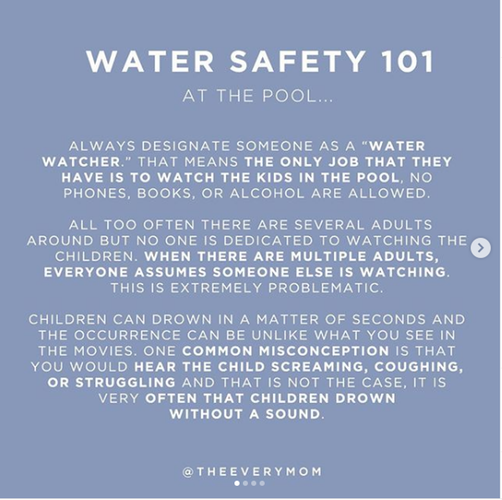
Remember: the best water safety strategy is to have multiple layers of safeguards in place at all times. (Think locks, fences, gates, constant adult supervision, you name it. If you have a pool, check out our Pool Safety Basics for Children.) Learning how to swim is just one of those layers. (Plus, swim lessons are fun, right?)
Now that we’re done with our crash course on water safety, let’s talk about timing.
When Should Your Kid Start Swim Lessons?
There’s no clear answer to this question. To a certain extent, when you start swim lessons doesn’t actually matter — starting is the important part. Age is just one piece of the puzzle, and since every child is different – emotionally, physically, and mentally – the best time to begin lessons varies from one kid to the next. As the AAP mentions in its newest recommendations, “parents should decide whether to enroll an individual child in swim lessons based on the child’s frequency of exposure to water, emotional development, physical abilities, and certain health concerns related to pool water” — according to the AAP, 4 years is something of a magic number…
Many researchers state that kids can’t reliably swim until they’re around 4, when most have developed the cognitive skills necessary to be able to swim independently. Some instructors even say that kids can’t be proficient swimmers until even later, at age 6. This may be true on average, but it’s clearly far from universally “correct.” Globally, this statistic doesn’t hold up – studies have shown that toddlers in other cultures are able to learn to swim around the same time they learn how to walk. We’ve seen many kids in Florida who start swim lessons quite early, swimming fully on their own by around 2-3.
We think it’s a great idea to have your tot take lessons before 4 years, but it might be helpful to temper your expectations. Plenty of little ones who spend lots and lots of time in the water pick up swimming swiftly. But for many young children who aren’t familiar with being in the water, their first swim “lessons” are more about getting them comfortable vs. learning how to actually swim.
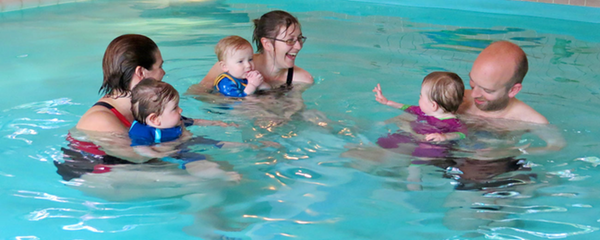
There are other benefits to bringing toddlers – and even infants – into the water. Younger children (much younger, even babies) can learn some rudimentary, but voluntary, water “behaviors.” Some studies have shown that swimming can improve coordination and balance, sleep and appetite, and even verbal and reading skills. Plus, helping young children grow comfortable being around the water and spending time in the water will help lay the foundation for their developing swim skills over the next few years. It sets the stage.
Note that babies should not stay in the water for more than 30 minutes, as they are more prone to hypothermia. Ideally, swim and water classes for kids younger than 3-years-old should be held in pools heated at 87 to 94 degrees Fahrenheit. If you notice that your baby is cold, take him out.
At the end of the day, when to start depends on where you see your child’s readiness for swim lessons, as well as your family’s context. If you live somewhere with a high pool density, or spend a lot of time in or near the water, you might be more compelled to start earlier. But even if you just want to acclimate your child to the water, you can start pretty much… whenever you want!
Which takes us to the main event…
What Kind of Swim Lessons Can Your Little One Take?
There are a few different broad options available in terms of aquatics instruction, and there’s all of zero evidence available suggesting that any one tack works better in terms of actually teaching swimming (a single doctoral dissertation tried to address this, and reported that different methods of teaching yielded “no significant differences in the degree of aquatic learning among preschoolers” — hah!).
Essentially, here are the basic methods being taught:
1. Infant Swim Rescue (ISR)
2. Water readiness/introduction skills (“water competency”)
2a. Swim skills acquisition/learn to swim program (for children 4+)
1. Infant Swim Rescue (ISR):
ISR is the newer kid on the block in water safety – some people swear by it, others see it as worrisome. Here’s the scoop:
ISR is a drowning prevention technique that teaches babies how to reach the surface of the water, roll onto their backs, float, and breathe until help arrives. It’s quite stunning to see infants – just 6 to 12 months old – do this. It also works with toddlers, who learn to roll in alternate motions to get themselves to a pool edge or shoreline safely.
ISR literature and instructors are adamant that parents understand exactly what the program is and isn’t. ISR is not swim lessons and does not teach babies independence in the water. Rather, it’s designed as a safety measure and teaches babies survival skills to buy themselves a little time in case of a brief lapse in supervision, which, let’s face it, happens all the time.
Here’s how it works: most class sessions last for a period of weeks (usually ~6 weeks, but it differs for individual babies). Classes are daily and meet for just 10 minutes – because they are hard and intense. “This is not water enjoyment,” pediatrician Michael Middleton told a reporter from the Washington Post. “The child is being forced to do something they’re not comfortable doing.” (Middleton’s own children went through ISR.)
Indeed, instructors report that babies don’t really like the training (or them!) – almost every kid cries and generally appears miserable, at least for the initial classes. But ISR teachers are just fine with that. ISR isn’t about having fun or playing in the water, they say – it’s about preparing a baby or toddler for a possible emergency situation. We have a friend whose toddler almost drowned at grandma’s house on Thanksgiving Day when someone left the patio door open after letting the dog out. Case in point: short of locking ourselves in our homes, we cannot create bulletproof environments for our kids 100% of the time.
Real parents share the pros and cons of ISR
Pros:
- The results are real! Your child will make visible progress over the course of ISR classes.
- All the sessions are individual, and every class is completely tailored to your child. This alone has many benefits, from getting the instructor’s undivided attention to progressing more quickly to close water supervision at all times.
- You’ll get some peace of mind, knowing that your child has the tools to react more efficiently in case of an emergency.
Cons:
- ISR is time-consuming. You’ll have to go multiple times a week, for a few weeks.
- Babies don’t enjoy the sessions. It can be hard for parents to witness.
- ISR is expensive.
If you’re interested in ISR, be forewarned: lessons can be really tough for parents to watch. In fact, parents often struggle so much that they typically aren’t allowed to attend ISR lessons – it’s just baby and instructor. Babies usually practice with their clothes on, too, since the training is centered on responding to real-life accidents.
Most families who’ve had little ones go through ISR rave about it, but some experts (and everyday parents) see certain elements as problematic (even while overall they tend to admit that the “risks are not extreme“).
A number of specialists take issue with promotional YouTube videos that clearly breach the most basic water safety measures (and therefore depict almost absurdly unsafe water environments — no door locks to backyards, no adult supervision, no pool gates, etc.), but the ISR rhetoric is actually committed to raising awareness of multi-tiered water safety. It sees itself as an absolute last-resort measure in the worst-case scenario. Thus, much like comprehensive sex ed., it’s acknowledging reality.
There are some health risks associated with youngsters spending time in pools (such as regulating body temperature, swallowing water, and exposure to bacteria), but these are all reasons why ISR sessions are limited to just 10 minutes. A number of professionals also say there isn’t any evidence that ISR prevents drowning, but the “lack of evidence” argument here just doesn’t feel very compelling…
Some parents simply think it’s cruel to submit babies to these lessons, and they might be right. But proponents liken ISR to vaccines, saying that sometimes parents just “have to make our kids do the things we know [are] best for them.”
Given that ISR is demanding of babies and toddlers, and also that it’s far more expensive than the average session of swim lessons (running around $85 per week, as of 2015), it’s not a great fit for everyone. But it probably is a worthwhile consideration for anyone who has a pool, lives in an area with a lot of pools or exposed water, or spends a lot of time around the water.
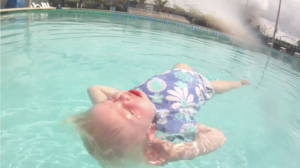
The purpose is to add an extra layer of safety and drowning prevention for families who have regular reason to be potentially worried about the water. If that applies to you – whether it’s in your backyard, at grandma’s house, on an upcoming summer vacation, or simply within your neighborhood – perhaps you might want to check it out.
You can look for instructors in your area at the official Infant Swim Rescue website. Another similar provider is Infant Aquatics. (Note: these programs are not universally or widely available yet, so you may have to travel or wait in line to be added to an instructor’s roster. You also might need to re-enroll annually or semi-annually to maintain your child’s skills and progress.)
2. Water Readiness/Competency Programs
These are the more run-of-the-mill swim lessons that are widely available, and they come in all different shapes and sizes. Most of these classes are offered through YMCAs, JCCs, local Red Cross Chapters and other community centers. Note that you do not have to subscribe to a religious affiliation in order to enroll in their programs — they are open to everyone!
Programs are designed to introduce young children to the water and generally are structured around water safety and awareness. Depending on age, they might incorporate instruction on walking around pools, how to enter or exit water, floating, recognizing a distressed swimmer, and building confidence/comfort around the water. Games and other fun elements (splashing! whoo!) are typically involved, too.
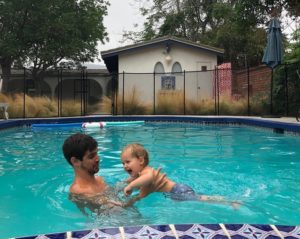
Real parents share the pros and cons of standard swimming classes
Pros:
- Traditional swim lessons are usually more affordable.
- You can sometimes participate in the program with your child.
Cons:
- In group lessons, your child will receive less individual attention and personal instruction.
- Courses tend to move more slowly, and many parents don’t feel their children make as much progress.
- Some parents go as far as to say that traditional swim classes often don’t appear to be really “doing anything” besides singing and splashing in the water.
The standard YMCA curricula advance from “water discovery” to “water exploration” to “water independence.”
Most classes for babies and toddlers are parent/child classes, and many of them are actually geared towards teaching parents how to be safe with their children in/around the water (sneaky!).
If you’re looking for a way to introduce your child to the water in a comfortable, fun, setting — or if you want an enjoyable way to spend some time with your kiddo — this is your best bet. As your child becomes more capable, these can gradually transition into more “swim skills” lessons.
Things to Look for in Swim Programs for Young Children:
- A teaching focus on water safety habits;
- Certified instructor(s);
- Low teacher-to-student ratio;
- “Touch supervision” – an adult (most likely you) should always be within arm’s reach of your child;
- A swimming environment with warm water temps, i.e. at least in the upper 80s (guess the North Atlantic is out!);
- An established curriculum with a set progression.
Note from the AAP’s family website: “If you’re worried that you can’t afford swim lessons, check with your city government. Many towns have scholarship programs that help cover the cost of swim lessons held at public schools.”
2a. Swim Skills Acquisition/Learn to Swim Programs
The next step would be more traditional swim lessons that focus specifically on swimming skills. These classes also progress from basic skills (kicking, floating, entering and exiting the water) to more advanced activities (like paddling, treading water, floating for longer periods, or front-and-back combined crawl).
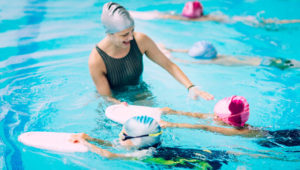
Ideally, your child would graduate into these kinds of lessons after taking exploratory classes as a toddler, but if you’re late to the game (like me), that’s OK too. Many of these programs also have a preliminary class designed to introduce “older” newcomers (3-5 years) to the water. *Make sure you speak to your instructor/program director to ensure your child is placed appropriately.
Overall, great places to look for “regular” swimming lessons for infants, toddlers, and preschool kiddos include your local YMCA, local government website, and area colleges or universities. The USA Swimming Foundation and the US Swim School Association also have great tools for finding lessons.
Parents share their best tips
- Be present! In group lessons, don’t assume that the swim instructor’s eyes are always on your child.
- Ask friends, neighbors, and local parents for recommendations in your area.
- Remember that swimming takes time and practice. Be realistic about what your child can and will learn in lessons.
- If the temperature is a big stumbling block for your child, consider buying a wet suit.
- Even if your child is becoming a strong swimmer, life jackets are recommended for activities like boating, rafting, and swimming in open water
Swim lessons are important for every child, but when, where, and how to approach them ultimately depends on you, your family’s living situation and your little one’s interest and ability. Even among our own team, we’ve all used different approaches for our kids, and there are no regrets. Regardless of your approach, knowing what to look for in classes and taking proper precaution can help make the next dip you take with your little one fun and rewarding — and dare we say, even relaxing?

Good luck!
Thank you SO much for this! 💕
I’m so glad to see ISR lessons on this list! My daughter started them last summer at 9 months old and is back for maintenance this summer learning the swim-float-swim sequence. It’s absolutely amazing to see her learn this. It is very time consuming and can be expensive (ours is $120/week), but anything that gives her a possible chance of saving herself in the event she makes it into water unattended is priceless to me. I wish this was more widely available so all children could learn these skills.
Tips for swim lessons and twins ( single mom)?
Hi Emily! Our twins editor suggests looking into private lessons where you could get in and hold one child while the instructor holds another. Another thought, is if you stagger two lessons so that you aren’t wrangling two kiddos at once.